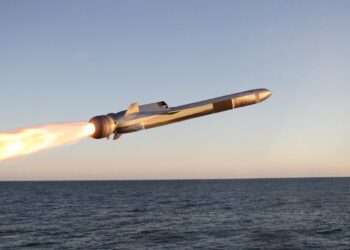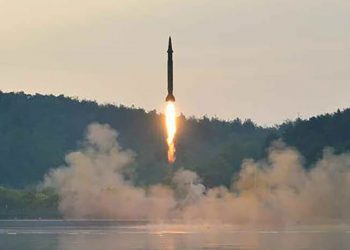Moscow: The planned deployment of American anti-ballistic-missile (ABM) components in Poland and the Czech Republic has provoked heated debates among Russian experts on how the country should respond. One of the questions they are discussing is whether Russia should withdraw from the 1987 treaty on intermediate- and shorter-range nuclear missiles (officially known as the Intermediate-Range Nuclear Forces (INF) Treaty).
The discussion was launched by Chief of the General Staff Yury Baluyevsky, who said: “Russia has the grounds for returning intermediate- and shorter-range missiles to its arsenal.” The Russian military has used this treaty as a bargaining chip in various situations. When former U.S. Defense Secretary Donald Rumsfeld proposed to his Russian counterpart, Sergei Ivanov, last August that his country join the United States' initiative to replace ICBM nukes with conventional warheads, the latter advised him to consider withdrawing from the INF Treaty.
In 2001, when Russia discussed its “asymmetrical response” to the United States' withdrawal from the ABM Treaty (which followed in 2002), Lt. Gen. Vyacheslav Romanov, head of the Russian general staff's center for nuclear security, declared that Russia would respond to the American deployment of a national ABM system by redeploying its intermediate- and shorter-range missile force – that is, the missiles that were aimed at Western Europe throughout the Cold War.
On the following day, the then Defense Minister, Igor Sergeyev, refuted this statement by his subordinate in very strong terms, calling the very idea that Russia might deploy its intermediate- and shorter-range missiles “absurd.”
Today's proposal is more flexible: quit the INF Treaty but equip intermediate- and shorter-range missiles with conventional warheads instead of nukes – ostensibly in this case, they would not threaten Europe or China. But if the United States refuses to modify the treaty, and gives Russia the chance to forget all about it – that is, have nuclear-tipped missiles – Europe and even China will blame Washington for not taking their interests into account.
As distinct from all-purpose strategic missiles, intermediate- and shorter-range missiles have a definite range – up to 5,500 km – that enables them to reach both China and Europe. What is the difference between replacing nukes with conventional warheads on ICBMs, as Rumsfeld suggested, and on intermediate- and shorter-range missiles? Both moves would lower the threshold for their use.
There is one more proposal: to offer countries with intermediate- and shorter-range missiles, that is, China, North Korea, India, Pakistan, Iran and Middle Eastern nations, to sign a treaty, and if any of them rejects the idea, to declare that Russia will withdraw from the INF Treaty but agrees with the United States that such missiles should only be deployed on the territory of the countries that possess them (in other words, there should be no U.S. missiles of that range in Europe). But what if the United States rejects this idea?
Russia does not even have any plans to develop these missiles, whereas the United States is intensively developing submarine-based medium-range missiles. Moreover, frightened Europe will turn to its big brother for protection. In that case, the deployment of U.S. medium-range missiles would create a worse headache for the Russian strategic nuclear force than it did in the 1980s, because now NATO is much closer to the Russian border, and its missiles could reach our launch sites in a matter of minutes.
The Defense Ministry argues that it is capable of resuming the production of ballistic missiles with a range of 500 km to 5,000 km. These could be medium-range RSD-10 Pioneers of Soviet make, destroyed under the INF Treaty, or the latest Iskander systems. Indeed, the Pioneer was a good missile, and the Soviet military mourned its destruction. But unlike its successor, Topol, it was not capable of evading an ABM system. This year, we will have to muster all our efforts in order to produce 17 Topol-M missiles, as opposed to the three made in 2006 (at a recent news conference, Nikolai Solovtsov said that the Russian strategic nuclear force will receive seven Topol-M launchers in 2007).
Of the five tests of the new Bulava, four were unsuccessful, which may be a serious obstacle to deploying them as planned on the new Borey class (Project 955) submarines. On top of all that, there are the unforeseen expenses of intermediate- and shorter-range missiles. The scientific editor of the magazine Arms Export, Mikhail Barabanov, has calculated that manufacturing 50-100 medium-range missiles would cost the same as producing several dozen Topol-M ICBMs. It is better to have an all-purpose Topol than an upgraded Pioneer of limited use.
As for short-range missiles (those that can hit targets 500 km to 1,000 km away), there is a proposal to increase the range of the Iskander tactical systems from 280 km to 500 km. A mere 60 systems would be required in the next nine years. But a range of 500 km is not the same as one of between 500 km and 1,000 km. Listing Iskanders in the category of short-range missiles is just wishful thinking.
So what should Russia do? How should it respond to the challenge? One suggestion is to withdraw from the treaty on conventional forces in Europe. By doing so, however, we wouldn't scare anyone, since our weapons are inferior to their American counterparts in all respects. For obvious reasons, it makes little sense to compare NATO with the Collective Security Treaty Organization (CSTO), comprised of Russia and five former-Soviet republics (Armenia, Belarus, Kazakhstan, Kyrgyzstan, and Tajikistan). In any case, the two organizations practically do not have any contacts.
The purpose of politically menacing medium-range ballistic missiles may be served just as well with much cheaper air-launched cruise missiles. The Rosbalt agency wrote that two years ago, Russia conducted a successful test of its X-555 cruise missile with a range of up to 5,000 km, circular error probable of 18-26 meters, and speed of Mach 0.77. It flies at tree-top level – 40 m to 110 m – which allows it to evade ABM systems. In early February, the ARMS-TASS news agency reported that India and Russia had begun joint research and development on a cruise missile that can fly several times the speed of sound.









